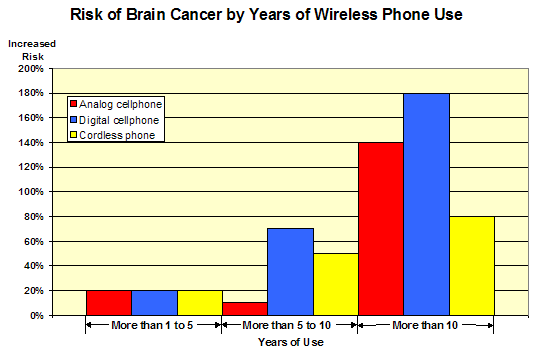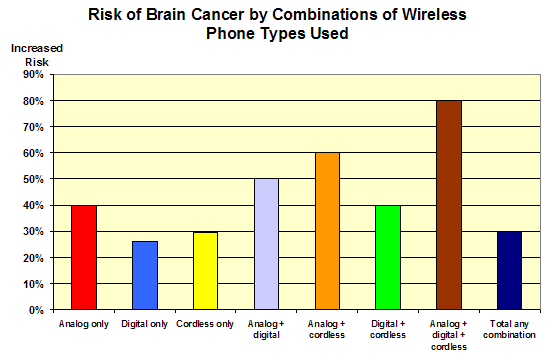|
 
|
Lloyd Morgan's Column
[Return to column index]
The Latest Study on the Risk of Brain Cancer From Wireless Phone Use1
This commentary is about the latest Hardell et al. scientific study on the
risk of brain cancer from wireless phone use. It is the 13th in a
series of papers published by this team [1-12].
Although every one of these studies has shown a risk of brain tumors from
wireless phone use (cell as well as cordless), the findings in this study are
the most alarming yet.
The findings are alarming for three reasons:
First, because they flow from a study of the worst type of brain tumors:
those collectively referred to as "brain cancer" (e.g., gliomas, astrocytomas,
glioblastoma multiforme--AKA GBM--etc.). The survival statistics for these tumors
are very grim (e.g., one year GBM survival is 29%) and the devastating effects,
even if there is survival, can be heartbreaking including loss of physical,
emotional and mental abilities.
Second, this study is alarming because it shows an increased2 risk of brain cancer no matter how examined
the wireless phone use was examined: Whether by cumulative hours of use, by
years of use, by use of the wireless phone on the same side of the head as the
tumor, or by types and/or combinations of wireless phones used.
Third, because these results show an extraordinarily short latency
time from the first use of a wireless phone to the diagnosis of brain cancer.
This short latency time has been seen in almost all of the studies done by this
team and has been confirmed in 5 out of 7 of the cellphone industry-funded
Interphone studies [13-17].
1 Lennart Hardell, Michael
Carlberg, Kjell Hansson Mild , Pooled analysis of two case-control studies on
use of cellular and cordless telephones and the risk for malignant brain tumours
diagnosed in 1997-2003; Int Arch Occup Environ Health. 2006 Mar 16
2 Throughout this commentary I
report the increased risk of a brain tumor. The science papers report OR (odds
ratio, the odds that a case will have a brain tumor compared to a control).
Thus, an OR=2.0 is equivalent to a 100% increased risk of a brain cancer.
Let me elaborate on some of the findings from this study.
Hardell's. study looked at 905 cases of brain cancer, ages 20-80, diagnosed
between 1997 and 2003 with 2,162 controls matched by age, sex, Social Economic
Index (SEI, a measure of wealth) and year of diagnosis. These 905 cases are the
combined results of two previous studies [7,12].
Again, it bears repeating, no matter how this study examined the risk of
brain cancer from wireless phone use (analog cellphones, digital cellphones and
cordless phones) it found a substantial increased risk of brain cancer:
- Analysis by cumulative hours of use:
As can be seen in the following graph the increased risk of brain cancer
grows as the number of cumulative hours grows, regardless of the kind of
wireless phone used.
- Analysis by years of use:
The graph below shows that there is an increased risk even for a very short
period of time (1 to 5 years), then increases dramatically for longer
periods of time.
- Analysis by use of wireless phone on the same side of the head as tumor:
The side of the head where a wireless phone is used is where the brain
absorbs most of the phone radiation. Once again, as has been found in many
other studies including the industry-funded Interphone studies, [15, 16, 17] there is an increased risk of brain
cancer on the same side of the head as phone usage.
- Analysis for type of wireless phone use and for combinations of types of
wireless phones:
Every phone type shows an increased risk of brain cancer. And with a
combined use of wireless phone types, there is an even greater risk. As can
be seen in the following graph there is just no such thing as a safe
wireless phone.
It is clear that the Hardell et al. study provides yet more worrisome
evidence of the health risks of unmitigated cellphone use. However, as
concerning as these latest findings certainly are, the most troubling aspect of
the Hardell et al. study is that of the early latency times it is demonstrating
with regards to cellphone exposure. It is well known that the time from exposure
to a carcinogen to the diagnosis of a tumor takes decades (25 to 40 years), yet
we are seeing an increased risk of brain cancer for as short as 1 to 5 years and
a broad consensus from all studies for use of more than 10-years.3
Could the implication be then, that what we are seeing is actually the tail
of a 25 to year latency time distribution?
3 Seven of the nine industry
funded Interphone studies have shown a risk of brain tumor where cellphone use
is 10 or more years.
References
- Hardell et al., Use of cellular telephones and the risk for brain
tumours: A case-control study; Int J Oncol. 1999 Jul;15(1):113-6
- Hardell et al., Use of cellular telephones and the risk for brain
tumours: A case-control study; Int J Oncol. 1999 Nov;15(5):1045-7.
- Hardell et al., Case-control study on radiology work, medical x-ray
investigations, and use of cellular telephones as risk factors for brain
tumors; MedGenMed. 2000 May 4;2(2):E2
- Hardell et al., Ionizing radiation, cellular telephones and the risk for
brain tumours; European Journal of Cancer Prevention 2001, 10, 523-529
- Hardell et al., Cellular and cordless telephones and the risk for brain
tumours; European Journal of Cancer Prevention: Volume 11(4) August 2002 pp
377-386
- Hardell et al., Case-control study on the use of cellular and cordless
phones and the risk for malignant brain tumours; Int J Radiat Biol. 2002
Oct;78(10):931-6
- Hardell et al., Further aspects on cellular and cordless telephones and
brain tumours; Int J Oncol 2003 Feb;22(2):399-407
- Hardell et al., Vestibular schwannoma, tinnitus and cellular telephones:
Neuroepidemiology. 2003 Mar-Apr;22(2):124-9
- Hardell et al., Use of cellular telephones and brain tumour risk in
urban and rural areas; Occup Environ Med 2005;62:390-394
- Hardell et al., Cellular and Cordless Telephone Use and the Association
with Brain Tumors in Different Age Groups; Arch Environ Health. 2004
Mar;59(3):132-7
- Hardell et al., Case-control study on cellular and cordless telephones
and the risk for acoustic neuroma or meningioma in patients diagnosed
2000-2003; Neuroepidemiology. 2005;25(3):120-8.
- Hardell et al., Case-control study of the association between the use of
cellular and cordless telephones and malignant brain tumors diagnosed during
2000-2003; Environ Res. 2006 Feb;100(2):232-41.
- Lönn et al., Mobile Phone Use and the Risk of Acoustic Neuroma;
Epidemiology Volume 15, Number 6, November 2004: 653-659
- Schoemaker et al., Mobile phone use and risk of acoustic neuroma:
results of the Interphone case-control study in five North European
countries; British Journal of Cancer (2005), 1 -7.
- Hepworth et al., Mobile phone use and risk of glioma in adults:
case-control study; BMJ. 2006 Jan 20.
- Lönn et al., Long-Term Mobile Phone Use and Brain Tumor Risk; Am J
Epidemiol 2005;161:526-535.
- Schüz et al., Cellular Phones, Cordless Phones, and the Risks of
Glioma and Meningioma (Interphone Study Group, Germany); Am J Epidemiol.
2006 Mar 15;163(6):512-20.
|









